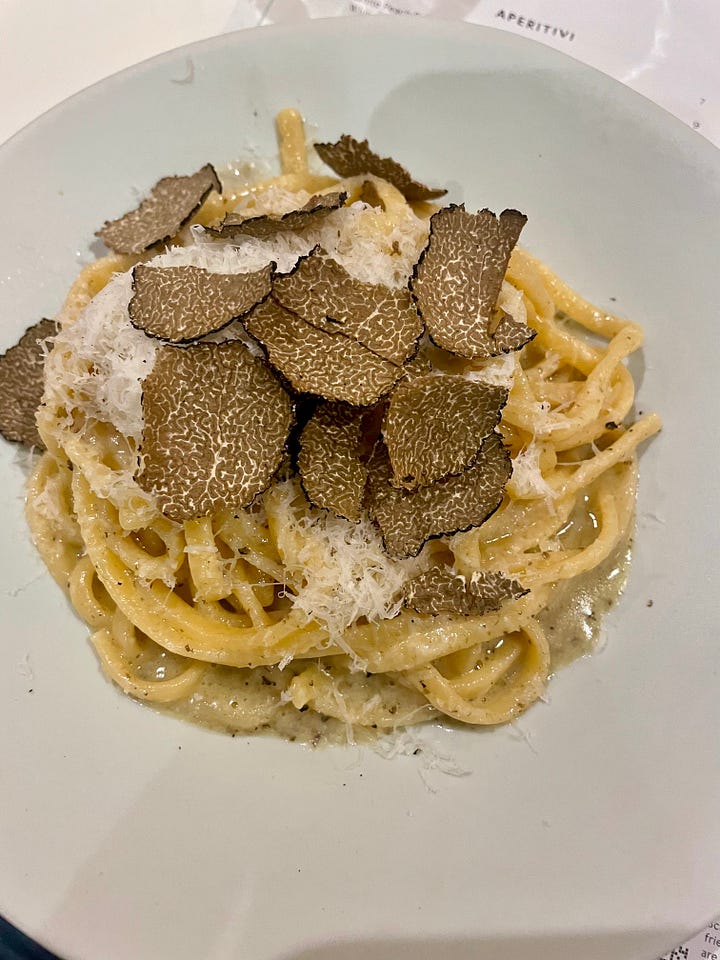The heart of Italian London transformed
The different fates of two iconic Italian grocers tell us a lot about a century of change in Soho - and about today's food culture. Plus: what I've been drinking this week




Sitting in the buzzy bar downstairs at Lina Stores on Brewer St last week, I pondered the contrasting fates of this Italian institution and another venerable Soho grocer, I Camisa & Son. Camisa closed in August this year after 63 years on Old Compton St, despite a campaign by the Soho Society and a two-year stay of execution from landlord Shaftesbury Capital Plc.
It matters because, as the late chef Alastair Little once said with only a little exaggeration, “Soho is the food capital of Britain.”
Camisa blamed the rise of homeworking and the decline of commuter-based trade following the Covid pandemic. But the economic fortunes of such family stores have slid in recent decades. Central London rents have steadily increased: as Tim Lord, Chair of the Soho Society, comments, “even for a small site like Camisa, you’re looking at £100,000 or £120,000 a year in rent and business rates half that again, before you’ve even sold a sandwich.”
Gabriella Saccomani, whose parents Rosina and Giovanni Filippi bought Lina Stores in 1978, ran it with her husband Tony from the 1990s until selling up in 2009. “It was a problem trying to keep our heads above water,” she tells me. “We were waning towards the end.”
Fast forward to 2024 and Lina Stores now has three delis, six restaurants, an online shop and three branches in Japan, with a Manchester restaurant scheduled to open next year – as well as the bar I was sitting in beneath the original Brewer St deli. It boasts an annual turnover of £24.5 million and around 75 employees. Puzzled at this sudden transformation, I dug around online and found that the Filippis had sold the whole thing up to two twentysomething public-school entrepreneurs, Edward and Max Green, in 2009 – not that you would know that from the store’s website or press coverage. Was I right to feel a bit cheated?
That depends on how you read the long story of how it was that Lina Stores and I Camisa & Son ended up in such different places in 2024.
Lina’s and Camisa’s founders were both were part of an Italian community that swelled in Soho in the 1920s. Isidoro Camisa and his brother, Ennio, started their first grocer’s shop on Old Compton St in 1929. Meanwhile the eponymous Lina Parisio arrived in London from near Genoa in the early 1920s and soon met her life partner, Emilio Crippa. By 1939 he was running a food wholesale business and street kiosk, Continental Produce Importers, around the corner from Brewer St in Tisbury Court.
Many other Italians started restaurants and businesses in the streets around them. G Parmigiani Figlio, the grocers on the corner of Frith St and Old Compton St, was of similar 1920s vintage. Peppino Leoni started his legendary Soho restaurant, Leoni’s Quo Vadis, in 1926. Two years later saw the launch of Manzi’s fish restaurant in nearby Bateman’s Buildings. Further afield, Giovanni Quaglino opened his famous restaurant in 1929 (not that it ever served Italian food: Anglo-French Dover sole and the like only for its aristocratic clientele.) And Charles Forte, patriarch of the now-defunct Forte Hotels empire, started his Strand Milk Bar on Regent St in 1935.
World War II interrupted all this – but didn’t end it. The Camisa brothers were interned, along with many Italian nationals, and their shop closed; freed at the war’s end, they opened a new store on Berwick St in 1948, running it together until in 1961 Isidoro went it alone with his I Camisa & Son store. And in 1949 Lou and Caterina Polledri opened the famous Bar Italia on Frith St, bringing the first Gaggia coffee machine to London.
But the decline of Soho’s Italian food community had been a long time coming. The area’s Italian population declined from the 1960s. “We knew most of our customers,” says Gabriella Saccomani, “but even that was declining as Italians moved out into suburbs.” And running such shops and restaurants was a hard life that younger generations weren’t necessarily keen to take on: Saccomani remembers having to get up at 4am to start making the pasta down in the basement kitchen of Lina Stores.
Part of the problem for traditional Italian food businesses has been the very popularity of their cuisine. In the early 1970s, even spaghetti was hard to find in British supermarkets, and products like mozzarella and fresh lasagne literally unheard of. “Anyone who needed anything Italian had to come into the centre,” says Saccomani. Now – call it the Jamie Oliver effect – you can buy everything from prosciutto to fresh tortellini in a local Tesco. And even though supermarkets don’t sell the range of regional products that many Italian delis do, they offer a selection that is good enough for most British consumers. “Supermarkets have bashed us on the head,” concludes Saccomani.
Now – call it the Jamie Oliver effect – you can buy everything from prosciutto to fresh tortellini in a local Tesco.
G Parmigiani closed in the 2000s; the site is today a Caffè Nero. Leoni’s Quo Vadis sold up in 1996 to Marco Pierre White; it’s now owned by the Hart brothers and home to the flagship branch of their Barrafina chain, as well as to chef Jeremy Lee’s latest iteration of Quo Vadis. Manzi’s fish restaurant, once a favourite of celebs from Joan Collins to the Kray twins, closed in 2006 after years of decline. Ennio Camisa’s decendants closed the Fratelli Camisa store on Berwick St in 2013 and took it online, where it still trades from a warehouse in Hertfordshire. I Camisa & Son was sold in 2014 to Italian wholesalers Alvini; the Italians had already sold Lina Stores by then. Of the original Soho families, only Antonio Polledri now remains, still flying the flag at Bar Italia.
Commercial pressures loom large. Traditionally, small businesses often owned their premises’ freehold; they have done so less often as more of Soho is bought up by developers. That has made small shops less able to withstand the hit from rents during downturns. And the cost of refurbishing and expanding is prohibitive for most small family businesses.
The last government’s 2020 changes to planning laws have also had a significant impact. The new E “use class” got rid of the planning distinctions that had existed between restaurants, bars and shops, meaning that owners and developers no longer need planning permission to convert shops to into more bars or coffee shops.
“That’s completely damaged Soho’s retail businesses,” says Tim Lord. “Before the change, there would be a debate on land-use terms about keeping retail sites. Now, if there’s a historic retail sector that you want to protect, it’s very difficult.”
As his comments suggest, the decline of Italian culinary Soho is part of a much wider debate about gentrification, regeneration and the endless morphing of city neighbourhoods.
In some respects, nostalgia for a disappeared Soho is misplaced: in the 1970s it was also a grubby, seedy neighbourhood overrun by the sex industry. And at the same time as the strip joints and sex shops have disappeared, the number of residents has increased in Soho over the past couple of decades: as of 2021, around 3,000 people lived there – double the number in 2001, and including 800 social-rent homes. Moreover during the pandemic, the brief experiment in turning whole streets into al fresco terraces gave a glimpse of a different possible future.
It comes down, perhaps, to what kind of capitalism we want for our neighbourhoods: a generic global version or a more organic local one. An interesting recent piece by Galicia-based writer Brendan Boyle highlighted the challenges facing many small businesses in Spanish urban barrios, under pressure from online sales and global corporations such as Amazon. In a number of Spanish cities such as Barcelona and Sevilla, they’re also threatened by tourism, driving rents higher as Airbnb gobbles up flats once rented by residents and as neighbourhood stores convert to selling tourist tat. Thus tourists seek out authenticity – yet simultaneously destroy it.
Soho’s food businesses face some of the same pressures – at the same time as we long for the authenticity that traditional businesses represent. But if they modernise, they need to avoid kitsch too, as highlighted by the re-born Manzi’s restaurant, launched in July 2023 by the Wolseley Hospitality Group: the FT’s Ajesh Patalay commented that it “sometimes feels more like a theme park than a restaurant (the theme being The Little Mermaid)”.
So what does Italian Soho’s future hold? As long ago as 1999, Alastair Little wrote that he thought Soho’s “ethos and history does not sit well with the corporate world”. But he added: “In more realistic moments I recognise an inevitability about this, but remain convinced that it will be them who have to adapt to the magic of the place.”
That is essentially what the Green brothers have done at Lina Stores, launching a new website and online sales in 2016, followed by the Greek St restaurant in 2018. As Italian head chef Masha Rener told Eater website then, “How to evolve [the original stores] into a restaurant without deviating too far from the original, has taken many years of discussion.” I think they’ve done an admirable job. As I finished lunch at that restaurant this week - you really wouldn’t guess it hasn’t been there for decades - I wondered if this wasn’t, after all, as good a future for such businesses as it’s possible to hope for in a twenty-first century metropolis like London.
It's not quite the same as the original. Gabriella Saccomani told me about the pasta kitchen that used to be in the basement, today the space where I’d sipped a pricey Sardinian beer. “I can still remember my hubby, my cousin and two of the men working there trying to heave this enormous new pasta machine down the stairs,” she recalls. Now, “it’s been revamped to the nth degree. But it’s lovely to see it flourishing.”


What I’ve been drinking this week
Bodegas Tomàs Cusinè “Vilosell” 2021, Costers del Segre - this Tempranillo/Syrah/Garnacha blend from north-east Spain is good value for this kind of quality: lovely spicy fruit underpinned with peppery acidity, smooth tannins. So drinkable (The Wine Society, £11.95.)
Castel Firmian “Mezzacorona” 2019, Teroldego Rotaliano Superiore Riserva - the red wines of Teroldego Rotiliano Denominazione aren’t that well known in the UK: they’re from way up in Italy’s far North in Alto Adige, made from a grape no-one here has heard of, Marzemino. They’re never going to make grand wines but they’re very attractive: I wish I knew them better. This brims with open, sweet red fruit and fresh acidity - cries out for pasta (vintage N/A UK - was Wine Society - though All About Wine has the 2021, £12.49.)
Richard Kershaw Deconstructed Syrah “Lake District Cartref SH22” 2017, Elgin - one of the most serious and delicious Syrahs I’ve tasted in a while, and certainly the best I’ve had from South Africa. Fragrant, sweet fruit, complex and long yet pure, with an edge of bottle age. Not cheap but impressive (around £56 and available only in a case of six from Lay and Wheeler.)



Interesting read. Worth noting that Jamie's Italian was also a victim!
I must admit that I haven't been to Soho for a long time but I ate in Serafina which I thought was a family run restaurant, similar to you describe, in New York. It, too, turns out to be part of a big global chain, albeit run by Italians! Still the Carbonara was good and I washed it down with a nice bottle of Falanghina!
Thanks!